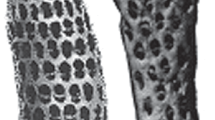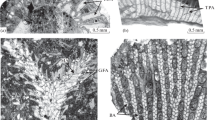Abstract
Fossil bryozoans sometimes contain fossilised brown bodies which remain after polypide degeneration. Position and shape of brown bodies as well as different skeletal diaphragms within living chambers allow outlining of autozooid anatomy in Palaeozoic trepostome bryozoans. In some trepostome bryozoans short autozooids were restricted by complete basal diaphragms to distal parts of autozooecia. In species with alternating hemiphragms, as in the specimen ofHemiphragma sp. described here, long autozooids occupied the entire autozooecial chambers. Their short polypides were positioned in distal parts of the autozooid. Both anatomic types correspond to the progressive polypide cycle afterBoardman. For species with ring septa, non-alternating hemiphragms (studied in an example ofNipponostenopora karatauensis) as well as without any diaphragms the stationary type of polypide cycle seems also to be possible. In that case, the polypides should be as long as the cystid.
Zusammenfassung
Fossile Bryozoen enthalten manchmal fossilisierte braune Körper, welche infolge der Degenration des Polypides entstehen. Position und Form der braunen Körper wie auch verschiedene Diaphragmen in Wohnkammern erlauben einige Schlüsse über Anatomie der Autozooide in Paläozoischen trepostomen Bryozoen. In einigen trepostomen Bryozoen waren kurze Autozooide mit kompletten basalen Diaphragmen auf distale Teile der Kolonien begrenzt. Taxa mit alternierenden Hemiphragmen wie das beschriebene Exemplar vonHemiphragma sp. besaßen lange Autozooide, welche die ganzen Wohnkammern ausfüllten. Ihre kurzen Polypide befanden sich in den distalen Teilen der Autozooide. Die beiden anatomischen Typen entsprechen dem progressiven Polypidenzyklus nachBoardman. Für Taxa mit ringförmigen Diaphragmen, nichtalternierenden Hemiphragmen (untersucht am Beispiel vonNipponostenopora karatauensis) wie auch ohne Diaphragmen scheint der stationäre Polypidenzyklus auch möglich. In diesem Fall sollen die Polypide genau so lang sein wie der Cystid.
Similar content being viewed by others
Literature
Astrova, G.G. 1978. The history of development, system, and phylogeny of the Bryozoa: Order Trepostomata. — Trudy Paleontologicheskogo Instituta A. N. SSSR169: 1–240 [in Russian].
Barnes, D.K. A &Clarke, A. 1998. Seasonality of polypide recycling and sexual reproduction in some erect Antarctic bryozoans. — Marine Biology131: 647–658.
Boardman, R.S. 1971. Mode of growth and functional morphology of autozooids in some Recent and Paleozoic tubular Bryozoa. — Smithsonian Contributions to Paleobiology8: 1–51.
Boardman, R.S. 1983. General features of the class Stenolaemata. — In:Moore, R.C., ed., Treatise on Invertebrate Paleontology, Part G (1): Bryozoa (revised): 49–137, Boulder (Geological Society of America, University of Kansas Press).
Boardman, R.S. 1998. Reflections on the morphology, anatomy, evolution, and classification of the Class Stenolaemata (Bryozoa). — Smithsonian Contributions to Paleobiology86: 1–51.
Boardman, R.S. 1999. Indications of polypides in feeding zooids and polymorphs in Lower Paleozoic Trepostomata (Bryozoa). — Journal of Paleontology73 (5): 803–815.
Boardman, R.S. 2000. The growth and function of skeletal diaphragms in the colony life of Lower Paleozoic Trepostomata (Bryozoa). — Journal of Paleontology75 (2): 225–240.
Boardman, R.S. &McKinney, F.K. 1976. Skeletal architecture and preserved organs of four-sided zooid in convergent genera of Paleozoic Trepostomata (Bryozoa). — Journal of Paleontology50 (1): 25–78.
Borg, F. 1926. Studies on Recent Cyclostomatuous Bryozoa. — Zoologiska bidrag från Uppsala10: 181–507.
Corneliussen, E.F. &Perry, T.G. 1973.Monotrypa, Hallopora, Amplexopora, andHenningopora (Ectoprocta) from the Brownsport Formation (Nigarian), Western Tenessee. — Journal of Paleontology47 (2): 151–220.
Cummings, E.R. &Galloway, J.J. 1915. Studies of the morphology and histology of the Trepostomata or Monticuliporids. — Proceedings of the Paleontological Society26: 349–374.
Ernst, A. 1998. Two unusual trepostome bryozoans from the Lower Carboniferous of the Karatau (South Kazakhstan). — Paläontologische Zeitschrift72 (1/2): 89–97.
Gordon, D. 1977. Aging process in bryozoans. — In:Woolacott, R.M. &Zimmer, R.L., eds., Biology of bryozoans: 335–376, New York (Academic Press).
McKinney, F.K. 1969. Organic structures in a Late Mississippian trepostomatous Ectoproct (Bryozoan). — Journal of Paleontology43 (2): 285–288.
McKinney, F.K. &Jackson, J.B.C. 1989. Bryozoan Evolution. — 238, Boston (Unwin Hyman).
Modzalevskaya, E.A. 1953. Trepostomaty ordovika pribaltiki i ikh stratigraphicheskoe znachenie. [Trepostomata of the Ordovician of East Baltic and their stratgraphic significance]. — Trudy Vsesojuznogo Nauchnoissledovatelskogo Geologo-Razvedochnogo Instituta (VNIGRI)78: 91–167 [in Russian].
Morrison, S.J. &Anstey, R.L. 1979. Ultrastructure and composition of brown bodies in some Ordovician trepostome bryozoans. — Journal of Paleontology53 (4): 943–949.
Ostroumoff, A.A. 1866. Contribution à l’étude zoologique et morphologue des Bryozoares de Golfe de Sebastopol. — Archives slaves de biologie1: 557–569,2: 184–190, 329, 355.
Prouho, H. 1892. Contribution à l’histoire naturelle des Bryozoaires. — Archives de zoologie expérimentale et générale10: 557–656.
Ulrich, E.O. 1890. Paleozoic Bryozoa. — Illinois Geological Survey8: 285–688.
Ulrich, E.O. 1893. On Lower Silurian Bryozoa of Minnesota. — Geology of Minnesota3 (1): 96–332
Utgaard, J. 1968. A revision of North American genera of ceramoporoid bryozoans (Ectoprocta): Part 2;Crepipora, Ceramoporella, Acanthoceramoporella, andCeramophylla. — Journal of Paleontology42 (6): 1444–1455.
Utgaard, J. 1973. Mode of colony growth. autozooids, and polymorphism in the bryozoan order Cystoporata. — In:Boardman, R.S., Cheetham, A. &Oliver W.A., Jr., eds., Animal Colonies: 317–360, Stroudsburg (Dowden, Hutchinson and Ross).
Wetzel, W. 1953. Organische Inhaltskörper danzeitlicher Bryozoenskelette. — Schriften des Naturwissenschaftlichen Vereins für Schleswig-Holstein (Gripp-Festschrift)25: 34–37.
Author information
Authors and Affiliations
Rights and permissions
About this article
Cite this article
Ernst, A., Voigt, E. Zooidal anatomy in Ordovician and Carboniferous trepostome bryozoans. Paläontol Z 76, 339–345 (2002). https://doi.org/10.1007/BF02989869
Received:
Accepted:
Issue Date:
DOI: https://doi.org/10.1007/BF02989869




